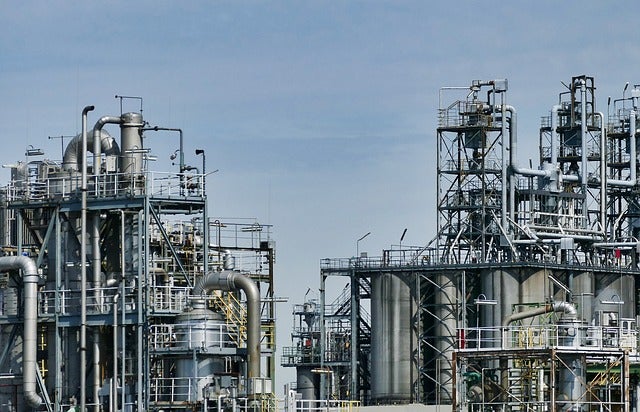
For companies in the industry, oil extraction is just the start as refining turns the liquid into more useful products – and the Asia-Pacific region plays a key role.
Oil refining is the processing of crude oil into petrol, gasoline, diesel and a range of petrochemicals that we use in our daily lives, especially in transportation.
The Asia-Pacific region has the largest oil refining capacity in the world, processing 34.75 million barrels per day (bpd) in 2018, according to a report published by BP Statistical Review of World Energy 2019.
It was followed by North America (22.33 million bpd) and Europe (15.68 million bpd).
NS Energy profiles the five countries with the biggest oil refining capacities in the Asia-Pacific region.
Asia-Pacific countries ranked by oil refining capacity
China
With a refining capacity of 15.66 million bpd in 2018, China tops the list of countries with the largest oil refining capacities in Asia-Pacific.
The country also ranks second among the countries with the largest oil refining capacity in the world.
The east Asian country is just behind the US, which had a capacity of 18.76 million bpd.
China contributed 15.6% of the world’s oil refining capacity in 2018.
According to data and analytics company GlobalData, China is expected to drive a significant part of the growth in the crude oil refining industry in Asia between 2018 and 2023.
The country is predicted to make up 44% of the crude oil refining capacity in the region in 2023.

Some of the major oil refining companies in China are China Petroleum & Chemical Corporation (Sinopec) and PetroChina, a subsidiary of China National Petroleum Corporation (CNPC).
The major refineries in China are SINOPEC Anqing Company Refinery, CNCP (PetroChina) Lanzhou Refiner, SINOPEC Beijing Yanshan Company Refinery, and SINOPEC CPCC Guangzhou Branch Refinery.
India
India holds the second position in the countries with the largest oil refining capacity in the Asia-Pacific region. The country’s capacity stood at 4.97 million bpd in 2018.
Accounting for 5% of the world’s oil refining capacity, the south Asian country also has the fourth-largest oil refining capacity after the US, China and Russia.
The Jamnagar Refinery, the world’s largest oil refinery in terms of capacity, is located in India.
Owned and operated by Reliance Industries, it is located in the north-western state of Gujarat and has a crude processing capacity of 1.24 million bpd.
Other major oil refineries in India are the Nayara Energy Refinery in Gujarat, the Kochi Refinery in Kerala, the Guwahati Refinery in Assam, the Panipat Refinery in Haryana, and the Visakh Refinery in Andhra Pradesh.
Some of the major oil refining companies in India are Oil and Natural Gas Corporation (ONGC), Bharat Petroleum (BPCL), Hindustan Petroleum (HPCL), and Reliance Industries.
South Korea
South Korea, with 3.35 million bpd capacity in 2018, has the third biggest refinery capacity in Asia Pacific.
The country accounted for 3.3% of the world’s refinery capacity per day.
Some of the country’s major operational refineries include the Ulsan refinery owned by SK Energy; the Yeosu refinery operated by GS Caltex, a joint venture between GS Holdings and Chevron; and the Onsan refinery in Ulsan, among others.

Located in Ulsan Metropolitan City in South Korea, the Ulsan Refinery has a processing capacity of 840,000bpd, and one of the world’s largest oil refineries in the world. It features five crude distillation units and a paraxylene unit as well as has two naphtha cracking units and a heavy oil upgrading facility with a capacity.
With a processing capacity is 775,000bpd, the Yeosu refinery is located at Yeosu city in South Jeolla Province. It has a desulphurisation facility with a capacity of 272,000bpd.
The Onsan Refinery, with a processing capacity of 669,000bpd, is one of the largest of its kind in the world. It features a condensate fractionation unit for producing additional naphtha.
Japan
Japan stands at fourth spot, with a refining capacity of 3.34 million bpd in 2018.
The country, which is also a major importer of oil, accounted to 3.3% of the world’s total refinery capacity.
The Sakai Refinery, with a refining capacity of 100,000bpd as of March 2018, is the major oil refinery in the country. Operated by Cosmo Oil, the Sakai refinery began operations in October 1968.
Some of the other refineries operational in the country include the JXTG Nippon Oil & Energy-operated Negishi Yokohama Refinery, the Showa Yokkaichi Sekiyu-operated Yokkaichi II, and the Kawasaki refinery.
The other refineries operated by JXTG Nippon Oil & Energy include Mizushima II, Sendai, Muroran, and Mizushima, among others. Idemitsu Kosan and Cosmo Oil are the other refinery operators in the country.
Singapore
Singapore ranks fifth with a refinery capacity of 1.51 million bpd in 2018. The country contributed to 1.5% to the world’s total refining production capacity.
With a capacity of 592,000bpd, the ExxonMobil-operated Singapore refinery, located on Jurong Island, is the major refining facility in the country.
The ongoing expansion project at the Singapore refinery involves the construction of new hydro-processing conversion units and a sulphur recovery facility, as well as the installation of a hot oil system, new interconnecting pipelines, and supporting infrastructure.
Additionally, Singapore Refining Company (SRC), a joint venture between Singapore Petroleum Company and Chevron Singapore, operates a refinery on Jurong Island. The refinery is capable of processing 290,000bpd.





